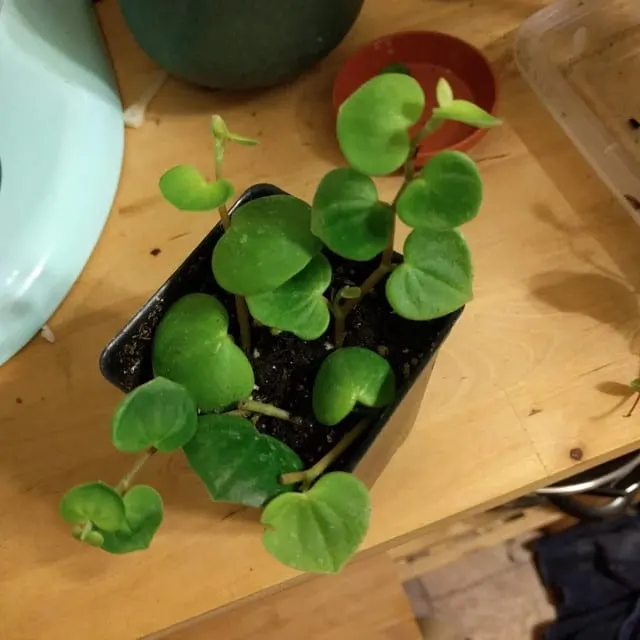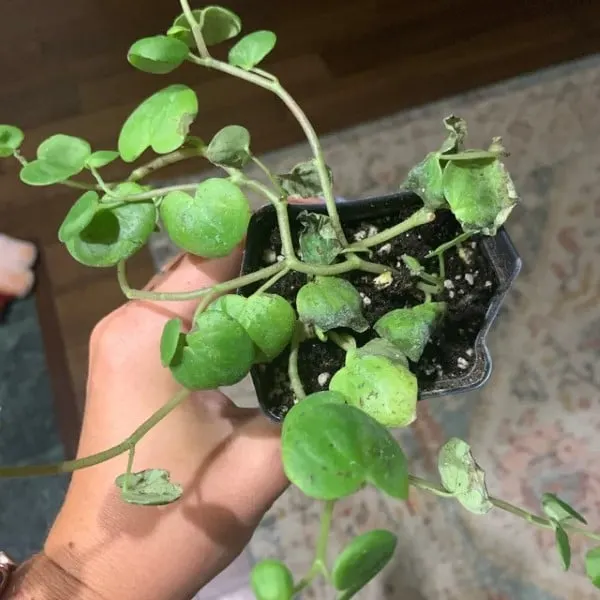Peperomia Serpens originated from the areas of South and Central America. It is a part of the Piperaceae family of plants, and it is known to capture people’s attention with its striking green foliage that instantly upgrades the aesthetics of any setting it is placed in.
A unique feature of the plant is that they can trail for which it is even called Vining Peperomia. You can keep this trailing plant in hanging baskets for a beautiful look.

The Main Characteristics of the Peperomia Serpens
Growth
The plant is small, making it easy to grow and maintain. When given proper care, the plant can grow up to a maximum size of 1 to 2 feet. However, the size doesn’t indicate that it doesn’t have a fast growth rate. It is observed that in the spring season, their leaves grow rapidly.
Furthermore, as it is a vining plant, it can spread in all directions. Therefore, pruning them occasionally can help to keep the plant in shape.
Leaves
The plant has broad heart-shaped leaves that are dark green. However, they do have a variegated variety, a mixture of green and yellow colors.
The leaves of the plant are also thick, shiny, and have a smooth surface compared to other plants that have textured surfaces.
The plant’s thick leaves can get damaged by holding up water inside for prolonged periods. The best way to protect them is to provide sufficient air circulation, which dries up the water on the leaves.
Flower
Generally, the Peperomia Serpens do not bloom any flowers. They are known for their rich green color and woody stem.
Diseases
The plant can have root rot caused by the over-watering of the plant. However, these plants don’t usually get affected by diseases; they are easy to grow and maintain.

Ways to take care of a Peperomia Serpens
Water
Like any other plant, it is important to understand how much you should water your Peperomia Serpens.
Peperomia Serpens doesn’t need high quantities of water to survive. Generally, it is recommended to check the soil. If the soil is wet, you should hold back on watering your plant until it begins to dry. It would be best to wait for the soil to dry out completely to water the plant again.
It is suggested that drainage holes be created in the pot to remove excess water retained at the bottom of the plant.
Soil
The plant grows healthy in soil with an acidic pH (Typically ranging from 4 to 6). Additionally, your plant will require soil that drains pretty well. A good way to ensure proper drainage of your soil is to poke holes at the bottom of the container you’ve planted your Peperomia Serpens in.
The soil should have air circulation and must be nutritious for growing a healthy Peperomia plant.
Lighting
Much like other plants, Peperomia Serpens also need a moderate light for growth. The ideal sunlight to meet the requirement of your plant would be bright but indirect sunlight.
Furthermore, it is suggested to keep the plant in a slightly shaded area. If this plant is being grown indoors, then it would be better to place the plant in an area that has shade. Curtains can be used to provide shade.
Keeping your plant in direct sunlight can damage the leaves and make the plant lose its bright green color.
Temperature
Peperomia Serpens can survive in a temperature ranging from 15°C–20°C. They cannot grow well in cold temperatures; hence special care is required in this season.
The plant can grow relatively well in warm temperatures as long as it is not exposed to direct sunlight. Very high temperatures can increase the chances of infectious attacks and diseases.
Humidity
As these plants are native to tropical regions, they survive well in humid conditions. A range of 35%-55% is required for the plant to grow.
If your home region is of a drier climate, it is recommended that either humidifier or regular misting is done to give the plant adequate humidity for healthy growth.
Fertilizers
A plant needs fertilization as standard potting soil will not be enough to provide the plant with sufficient nutrition to grow properly. Similarly, Peperomia needs fertilization to enhance their growth.
However, fertilizers should be given in a moderate amount as too much can damage the plant. They should be given a balanced amount of fertilizer, few times a month.
Pruning
The plant doesn’t require any extra maintenance in terms of pruning. As the size of the plant is very short, pruning them regularly might damage the plant. Therefore, pruning can only be done if there are any dead or damaged leaves.
Propagation methods of Peperomia Serpens
There are two propagation methods to grow Peperomia Serpens. They are,
- Water propagation
- Soil Propagation
Water via Propagation
- Firstly, cut a stem cutting from the existing plant.
- Make sure that only a few leaves are intact only on the upper side of the plant.
- After that, place the stem into a container filled with clean water.
- New water should be replaced with old to protect the plant from any infectious attack.
- The jar should not be kept in direct sunlight as it will affect the growth of the plant.
- Watch your plant on a regular basis.
- Once the plant grows a certain height, it can be replanted into the soil.
Soil Propagation
- Start by sanitizing your scissors.
- After that, remove a stem from the mother plant, and no leaves should be left in the lower part of the plant.
- Place the stem inside the soil.
- Make sure that the soil is well-drained and not soggy.
- Notice the plant every week to see the growth.
Summary
The Peperomia Serpens are ideal for growing indoors due to their small and manageable size. The green and thick leaves are perfect to beautify any house.
They can grow well in an environment that is provided with all the conditions described above. To propagate a plant, the two techniques outlined above can be used.
